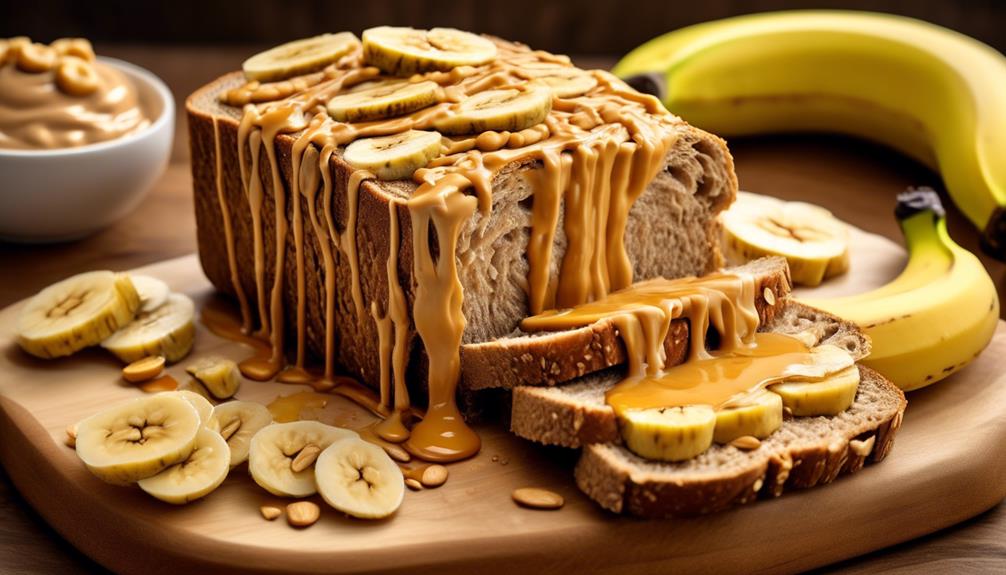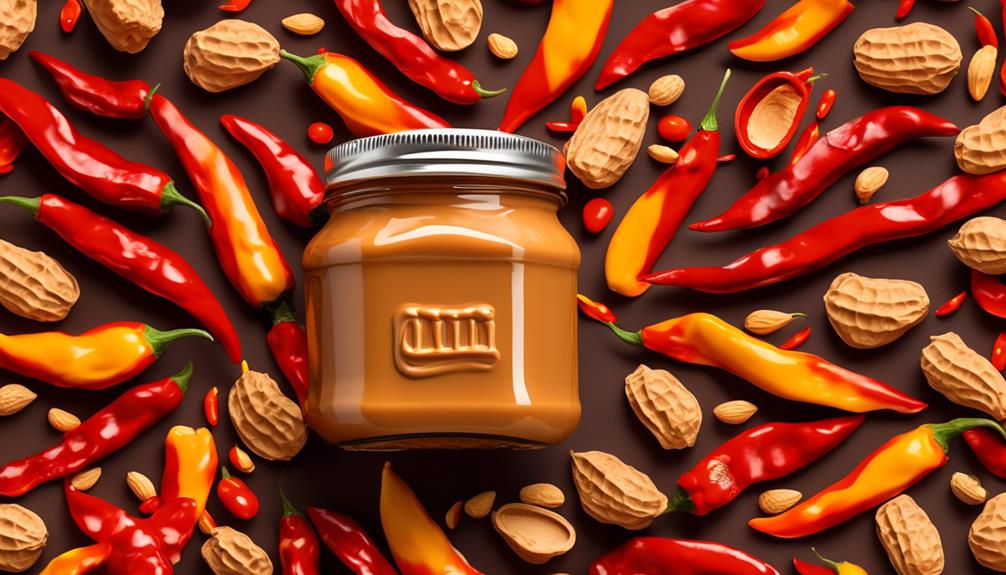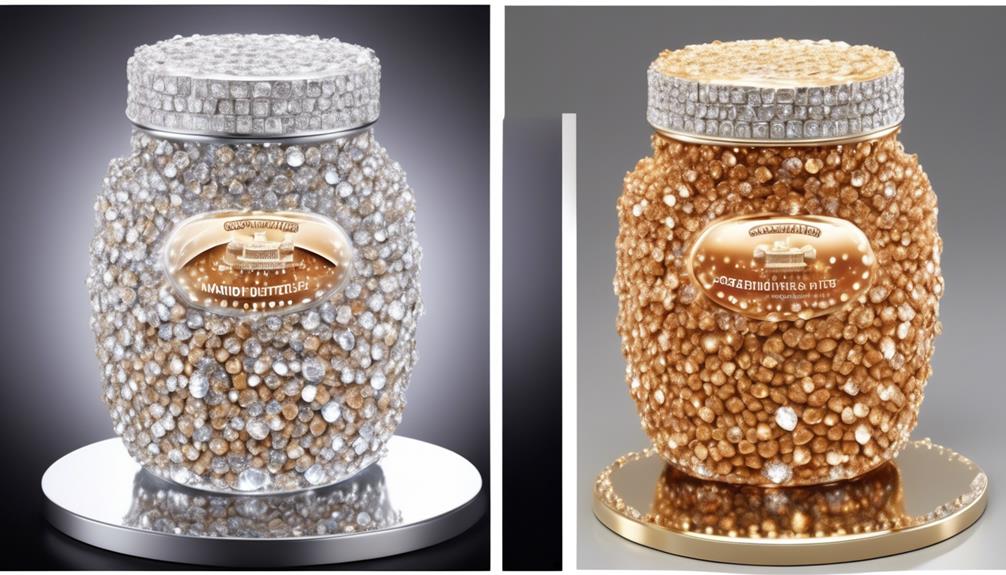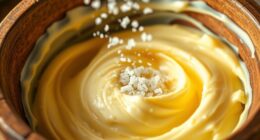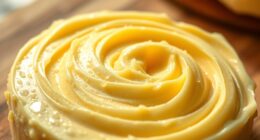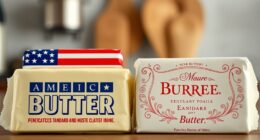We’ve all thought about how to evenly spread peanut butter on a piece of bread. It’s quite a precise skill, isn’t it?
But have you ever wondered just how much peanut butter is the right amount? Let's just say, it's a bit more complex than it seems.
Stick around to uncover the secrets of achieving the ultimate peanut butter to bread ratio and why it's more important than you might think.
Key Takeaways
- Portion control is important for managing calorie intake and promoting overall health.
- The standard serving size of peanut butter is about two tablespoons, containing around 190 calories.
- Understanding serving sizes helps maintain a balanced diet and manage calorie intake.
- Reading nutrition labels helps manage portion control and servings per container.
The Importance of Portion Control
Understanding the importance of portion control is vital for managing calorie intake and promoting overall health. When it comes to foods like peanut butter, it's crucial to be mindful of portion sizes.
A registered dietitian can provide valuable insights into appropriate serving sizes to ensure a balanced diet. By practicing portion control, individuals can prevent overeating and manage their weight effectively.
Proper portion sizes also play a significant role in controlling the intake of fats, sugars, and carbohydrates, which are essential for maintaining stable blood sugar levels and energy throughout the day. Additionally, mindful portion control allows for enjoying a variety of foods without compromising a healthy diet.
It's important to recognize that even nutritious foods like peanut butter should be consumed in moderation to avoid excessive calorie consumption. By being aware of portion sizes and seeking guidance from a registered dietitian, individuals can make informed choices that contribute to their overall well-being.
Understanding Serving Sizes

When considering serving sizes for peanut butter, it's crucial to understand the nutritional composition and recommended portion sizes to make informed dietary choices.
For example, a standard serving of peanut butter is about two tablespoons, which contains around 190 calories. This information is valuable when deciding how much peanut butter to spread on a plain bagel or a slice of whole-wheat bread.
Understanding serving sizes is essential for maintaining a balanced diet and managing calorie intake. By being aware of the recommended portion sizes, individuals can better control their consumption of peanut butter, which is high in healthy fats and protein but can contribute to excess calorie intake if not portioned correctly.
Additionally, being mindful of serving sizes can help individuals meet their nutritional needs without overindulging. Reading nutrition labels to determine the serving size and the number of servings per container is a practical way to manage portion control.
Spreading Techniques for Even Coverage

To achieve even coverage of peanut butter on a slice of bread, consider using a butter knife and spreading a thin, evenly distributed layer across the entire surface. When spreading peanut butter, it's essential to apply the right technique to ensure an even and satisfying result. Here are some effective spreading techniques for achieving even coverage:
- Use a butter knife to spread the peanut butter evenly from edge to edge.
- Start with a small amount of peanut butter and spread it thinly to cover the bread completely.
- Apply gentle pressure while spreading the peanut butter to ensure an even layer across the entire slice.
- Use a back-and-forth motion with the knife to distribute the peanut butter evenly without tearing the bread.
These techniques help in achieving a consistent layer of peanut butter on the bread, ensuring that each bite delivers the perfect combination of flavors.
Additionally, warming the peanut butter slightly can make it easier to spread and achieve even coverage, enhancing the overall experience of enjoying a tablespoon of peanut butter on a slice of bread.
Finding the Sweet Spot for Flavor

Exploring the delicate balance of flavors in a dish involves a thoughtful interplay of sweet, salty, sour, and bitter tastes to create a satisfying culinary experience. As we strive to achieve this balance, it's essential to consider the impact of different cooking methods, ingredients, and seasoning levels. To delve deeper into this, let's examine the key factors that contribute to finding the sweet spot for flavor.
| Factors to Consider | Impact on Flavor |
|---|---|
| Ingredient Quality | Fresh, high-quality ingredients elevate the overall taste of the dish. |
| Cooking Techniques | Different methods like grilling or roasting can enhance natural flavors. |
| Seasoning Levels | Balancing the right amount of sweet, salty, sour, and bitter flavors is crucial. |
| Flavor Development | Understanding how cooking methods affect flavor development is essential. |
Achieving the Right Texture

Balancing the delicate interplay of flavors in a dish, we now shift our focus to achieving the right texture for peanut butter, ensuring a satisfying mouthfeel that combines creaminess with a slight grittiness for enhanced depth of flavor.
- To achieve the perfect texture of peanut butter, we need to make sure it's smooth and spreadable while retaining a slight graininess from the crushed peanuts, adding an extra layer of flavor.
- It's crucial to ensure that the peanut butter isn't overly oily but has a creamy consistency that holds together well, providing a satisfying experience with every bite.
- The ideal peanut butter texture should be easily spreadable, with a luxurious mouthfeel that melts in the mouth without feeling greasy or dry, making it a delight to consume.
- Balancing the texture of peanut butter involves finding the right combination of smoothness and thickness to cater to personal preferences and various applications, ensuring that it meets the expectations of different consumers.
Nutritional Considerations

Considering the serving size and calorie count is crucial when incorporating peanut butter into our diet. Peanut butter is a calorie-dense food, so portion control is essential. Two tablespoons of peanut butter typically contain around 180-200 calories, so it's important to be mindful of the amount we consume.
Besides calories, we should pay attention to the fat, protein, and carbohydrate content in peanut butter. It's a good source of protein and healthy fats, but some varieties may contain added sugars or hydrogenated oils. When choosing peanut butter, be aware of the different options available, such as natural, flavored, and reduced-fat versions, each with its own nutritional profile. Reading labels is crucial to make informed choices and avoid unnecessary additives.
Additionally, consulting with healthcare professionals or a registered dietitian can provide personalized advice on portion control and how to incorporate peanut butter into a balanced diet.
Comparing Different Peanut Butter Types

When it comes to peanut butter, there are various types to consider, each with its own unique characteristics.
Smooth peanut butter offers a creamy texture, while crunchy peanut butter provides a delightful crunch with its small pieces of peanuts.
Additionally, natural peanut butter stands out for its simplicity, made solely from peanuts without any added ingredients.
Peanut Butter Textures
With its creamy or crunchy texture, peanut butter offers a variety of options for consumers to choose from, each providing a unique experience in taste and mouthfeel. When considering peanut butter textures, it's important to understand the differences between various types:
- Smooth peanut butter has a creamy texture, offering a velvety mouthfeel.
- Crunchy peanut butter contains small pieces of peanuts, providing a delightful crunch and added texture.
- Natural peanut butter, made with just peanuts, offers a slightly grainy texture and is a healthier choice.
- Flavored peanut butter, such as honey or chocolate-infused options, not only adds variety in taste but also introduces different textures to the spread.
These variations in texture cater to different preferences, making peanut butter a versatile and enjoyable addition to meals and snacks.
Flavor Variations
Peanut butter's diverse textures not only offer a range of mouthfeels but also contribute to a myriad of flavor variations, making it a versatile and enjoyable addition to meals and snacks.
Smooth peanut butter delights the palate with its creamy consistency, while crunchy peanut butter adds a delightful crunch from small pieces of peanuts.
Natural peanut butter, made solely from peanuts, offers an authentic nutty flavor, while flavored options such as honey and chocolate-infused varieties provide a sweet twist.
Reduced-fat peanut butter, with its lower fat content, still delivers that nutty taste but with a lighter touch.
Despite the variety in flavors, most types of peanut butter offer similar calorie counts, making it a delicious and satisfying choice for a range of dietary preferences and culinary creations.
Nutritional Differences
Comparing different types of peanut butter reveals distinct nutritional profiles, each offering varying fat content and calorie counts per serving.
- Regular peanut butter contains 16g of fat and 190 calories per 2-tablespoon serving.
- Natural peanut butter, made with just peanuts and a little salt, is the best option to avoid added sugars and hydrogenated oils.
- Peanut butter is naturally cholesterol-free and rich in heart-healthy mono and polyunsaturated fats.
- Different varieties of peanut butter include smooth, crunchy, natural, flavored, and reduced-fat, each with distinct nutritional profiles.
Incorporating peanut butter into meals aids in weight management, as it provides a sense of fullness and is a good source of protein and healthy fats.
Making an informed choice based on these nutritional differences can help in aligning peanut butter consumption with dietary goals.
Tips for Avoiding Sogginess

When it comes to avoiding sogginess in peanut butter sandwiches, there are a few strategies that can help.
Spreading the peanut butter evenly across the bread can help maintain a crunchy texture.
Using thicker, denser bread varieties can also provide a sturdier base that's less prone to becoming soggy.
Additionally, layering moist toppings like jam between the peanut butter can help balance flavors while minimizing sogginess.
Spread Evenly for Crunch
To ensure an even layer of peanut butter without causing tears, we recommend using a butter knife to spread it evenly across the entire surface of the bread, applying light pressure. This method helps to avoid clumps and ensures a consistent spread.
In addition to spreading the peanut butter evenly, consider adding toppings for an extra crunch. Chopped nuts or granola can be sprinkled on top of the peanut butter to enhance the texture and flavor.
It's also important to pay attention to the edges and corners of the bread to ensure the peanut butter is evenly distributed.
Another tip to avoid sogginess is toasting the bread before spreading the peanut butter, which adds a delightful crunch to every bite.
Use Thicker Bread
Thicker bread serves as a protective barrier against sogginess by effectively absorbing the moisture from the peanut butter and maintaining the bread's integrity. It acts as a sturdy foundation, preventing the peanut butter from seeping through and making the bread soggy.
With its enhanced ability to absorb moisture, thicker bread reduces the risk of sogginess, providing a more enjoyable peanut butter experience. Opting for dense, hearty bread complements the rich and creamy texture of the peanut butter without compromising the bread's structure.
The thicker slices can withstand the weight and moisture of the peanut butter, ensuring that the bread remains firm and satisfying. By using thicker bread, you can create a more substantial and satisfying peanut butter snack or meal without the disappointment of soggy bread.
Add Jam for Balance
Consider incorporating a thin layer of jam with the peanut butter to achieve a harmonious balance of flavors without compromising the bread's texture. This combination not only enhances the overall taste but also helps in preventing sogginess.
Here are some tips for adding jam to maintain the texture and flavor balance:
- Spread a thin layer of peanut butter on the bread to provide a base for the jam.
- Ensure the peanut butter is evenly distributed to create a balanced flavor with the jam.
- Apply the jam immediately after spreading the peanut butter to prevent the bread from becoming soggy.
- Use a thicker layer of peanut butter if the jam is particularly runny to create a barrier and prevent sogginess.
These tips will help maintain the integrity of the bread while enhancing the overall taste experience.
Balancing Peanut Butter With Other Ingredients

Balancing peanut butter with other ingredients creates a harmonious blend of nutrients and flavors for a satisfying and wholesome meal or snack. When considering the calorie content and portion size, it's important to maintain a balanced combination. Pairing peanut butter with whole-grain bread provides a mix of protein, healthy fats, and carbohydrates for sustained energy. Adding sliced fruits or veggies to peanut butter toast enhances the nutritional value and adds a satisfying crunch or juiciness. Experimenting with different nut butters or spreads can vary the flavors and nutrient profiles of your balanced snacks or meals. It's crucial to be mindful of the overall fat and calorie content in the combination of peanut butter and other ingredients to create a well-balanced dish.
| Ingredient | Nutrient Benefits | Suggested Pairings |
|---|---|---|
| Whole-grain bread | Fiber, B vitamins, and complex carbohydrates | Peanut butter, honey, bananas |
| Sliced fruits or veggies | Vitamins, minerals, and fiber | Peanut butter, apples, celery |
| Different nut butters or spreads | Varied nutrient profiles and flavors | Almond butter, cashew butter, whole-grain crackers |
Enhancing the Presentation

When it comes to enhancing the presentation of peanut butter on a piece of bread, it's crucial to focus on spreading the peanut butter evenly to ensure a consistent taste in every bite.
Visual appeal is also important, so consider using tools like a butter knife or a spatula to create smooth, clean lines.
Additionally, it's essential to avoid overloading the bread with peanut butter, as this can lead to a messy and unbalanced final product.
Spread Evenly
To achieve an appealing visual presentation, evenly spreading the peanut butter from edge to edge of the bread is essential. Using a knife or spatula to evenly distribute the peanut butter helps avoid clumps or uneven patches. Paying attention to the corners and edges of the bread ensures an evenly coated surface, while checking the thickness of the spread maintains a consistent layer across the entire slice of bread. It's important to smooth out the surface of the peanut butter to create a uniform and polished appearance.
- Use a knife or spatula to evenly distribute the peanut butter, avoiding clumps or uneven patches.
- Pay attention to the corners and edges of the bread to ensure an evenly coated surface.
- Check the thickness of the spread to maintain a consistent layer across the entire slice of bread.
- Smooth out the surface of the peanut butter to create a uniform and polished appearance.
Visual Appeal
In examining the visual appeal of peanut butter on a piece of bread, the even spreading of the peanut butter becomes a crucial element in enhancing the overall presentation.
High-quality images and graphics play a significant role in capturing the attention of the audience and conveying the deliciousness of the peanut butter.
Incorporating complementary colors that align with the overall theme enhances the aesthetic appeal.
Utilizing white space effectively creates a clean and uncluttered visual appeal, drawing focus to the peanut butter itself.
Consistency in font styles and sizes contributes to a polished and professional look that elevates the presentation.
Additionally, the use of visual elements such as icons, charts, and infographics can make the information more engaging and understandable.
These factors collectively contribute to a visually appealing presentation that entices and delights the audience.
Avoid Overloading
Enhancing the presentation involves strategically incorporating visual aids, storytelling techniques, and interactive elements to effectively communicate information and engage the audience.
When it comes to avoiding overloading the audience, it's crucial to strike a balance between providing enough information and not overwhelming them. Here are some strategies to avoid overloading:
- Use visual aids such as charts, graphs, and images to enhance understanding.
- Employ storytelling techniques to make the information more relatable and memorable.
- Incorporate interactive elements like quizzes or polls to maintain audience engagement.
- Consider utilizing multimedia elements such as videos and audio clips to add variety.
Incorporating Peanut Butter Into Recipes

Incorporating peanut butter into recipes enhances their nutritional profile and can elevate their flavor and texture. Peanut butter is a versatile ingredient that adds a creamy richness and nutty taste to both sweet and savory dishes. Whether it's adding a dollop to a morning bowl of oatmeal for a protein boost, blending it into a smoothie for a satisfying snack, or using it as a base for a savory peanut sauce to drizzle over stir-fried vegetables, the options are endless.
When incorporating peanut butter into recipes, it's important to choose natural options with minimal added ingredients and no added sugars or hydrogenated oils. This ensures that you're getting the full nutritional benefits of peanut butter without unnecessary additives. Additionally, portion control is key when using peanut butter in recipes, as it's calorie-dense.
Peanut butter can be a valuable addition to a balanced diet, providing essential nutrients and healthy fats. Its ability to enhance the flavor and nutritional value of various dishes makes it a go-to ingredient for those looking to add a touch of indulgence without compromising on health.
Maximizing Enjoyment

To fully savor the flavors and textures of a dish, it's essential to focus on each bite and experiment with various consumption methods to maximize enjoyment.
- Engage all your senses: Take the time to appreciate the aroma, appearance, and presentation of the food. This sensory experience can significantly enhance your overall enjoyment of the meal.
- Mindful consumption: Pay attention to how the food makes you feel and the sensations it evokes. Being present and mindful while eating allows for a deeper connection with the food and can amplify the enjoyment.
- Experiment with pairings: Consider pairing the food with complementary flavors and beverages. Exploring different combinations can elevate the dining experience and add layers of enjoyment to the meal.
- Find your method: Experiment with different ways of consuming the food to find the most enjoyable method for you. Whether it's savoring small bites, combining different elements, or exploring unconventional pairings, finding your preferred consumption method can enhance overall enjoyment.
Frequently Asked Questions
How Much Peanut Butter Is Used on One Slice of Bread?
We typically use 1-2 tablespoons of peanut butter on one slice of bread, depending on personal preference. This amount provides a satisfying balance of protein, healthy fats, and flavor.
It's essential to consider the nutritional content and overall calorie count of peanut butter when determining the appropriate spread.
For a lighter option, a thin layer works well, while a thicker layer makes for a heartier snack or meal.
Experiment with different toppings like fruits, honey, or seeds for added nutrition and taste.
How Many Tablespoons of Peanut Butter Are in a Sandwich?
We usually use about 2 to 3 tablespoons of peanut butter in a sandwich, depending on personal preference and dietary needs. It's important to adjust the amount of peanut butter based on individual taste and nutritional requirements.
Considering portion sizes and nutritional content is key when adding peanut butter to a sandwich. Peanut butter offers a good source of protein, healthy fats, and essential nutrients, making it a versatile and nutritious addition to a sandwich.
How Many Grams of Peanut Butter on Toast?
Weighing 32.1 grams, the peanut butter on toast provides 11.6 grams of fat, 40.7 grams of carbohydrates, and 529.4 calories.
It's a substantial source of protein.
Is Peanut Butter on Bread a Healthy Snack?
Yes, peanut butter on bread can be a healthy snack. It provides a good balance of protein and healthy fats, which can help keep you feeling full and satisfied.
However, it's important to be mindful of portion sizes due to its calorie density. Opt for whole grain bread and natural peanut butter to maximize the nutritional benefits.
As with any snack, moderation is key to maintaining a healthy diet.
Conclusion
In conclusion, mastering the art of spreading the right amount of peanut butter on a piece of bread is like finding the perfect balance in life. It's about portion control, understanding serving sizes, and achieving the right texture for maximum enjoyment.
Just like a well-balanced sandwich, finding the sweet spot for flavor and presentation is key. So, take the time to perfect your peanut butter spreading technique and savor every bite.



